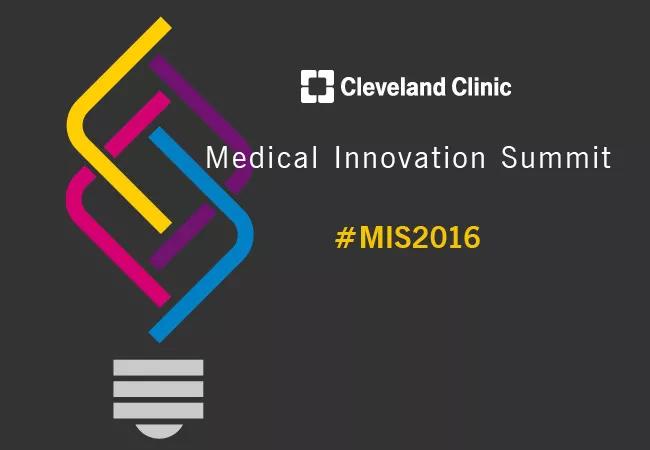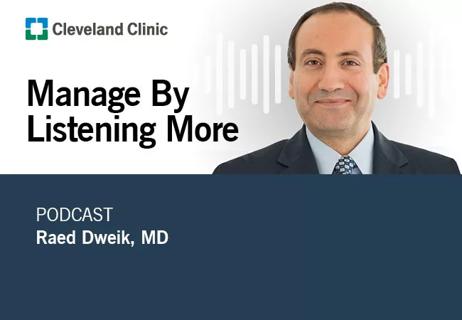Cleveland Clinic hosts 14th annual innovation summit

More than 1,700 healthcare stakeholders gathered in Cleveland, October 24–26, 2016, to discuss the latest medical breakthroughs and make new connections to spark future awe-inspiring innovations.
Cleveland Clinic is a non-profit academic medical center. Advertising on our site helps support our mission. We do not endorse non-Cleveland Clinic products or services. Policy
Now in its 14th year, Cleveland Clinic’s Medical Innovation Summit is the oldest and largest meeting of its kind in healthcare. The perennial highlight? The unveiling of the top 10 medical advancements for the coming year — those that Cleveland Clinic experts predict will change patient care forever.
Here are their picks for 2017, in order of anticipated importance:
Microbes in our bodies — and the chemicals they emit — interfere with the way food is digested, medicine is deployed and even how a disease progresses.
Biotech companies once focused on the genomic market are pivoting to the potential of the microbiome to develop new diagnostics, new therapies and “probiotic” products to prevent dangerous microbe imbalances.
With the National Microbiome Initiative’s accelerating research and development, experts believe 2017 is the year the microbiome becomes the healthcare industry’s most promising and lucrative frontier.
Half of patients with Type 2 diabetes will die from complications of cardiovascular disease. On their 65th birthdays, the odds go up to 70 percent.
In 2016, two new medications began reducing the mortality rates considerably. Empagliflozin modifies the progression of heart disease by working with the kidney while liraglutide has a comprehensive effect on many organs.
Given these positive results, experts predict 2017 will mark a complete shift in the lineup of medicines prescribed for diabetes patients — as well as a wave of research into new avenues targeting Type 2 diabetes and its comorbidities.
One of the first cellular immunotherapies for leukemia and non-Hodgkin lymphomas is about to hit the market. Chimeric antigen receptor T-cell therapies are a type of immunotherapy where a patient’s immune system T-cells are removed and genetically reprogrammed to seek and destroy tumor cells.
Results have been impressive. Some studies focusing on acute lymphoblastic leukemia (ALL) have reported a remission rate of 90 percent.
This groundbreaking treatment is expected to be presented to the FDA in 2017 for treatment of ALL. That could trigger a wave of approvals for other blood cancers and lymphomas as well. Cellular immunotherapy could one day replace chemotherapy and its lifetime of side effects.
Tests known as “liquid biopsies” uncover signs of actual DNA, or cell-free circulating tumor DNA (ctDNA), which is shed from a tumor into the bloodstream. This ctDNA is more than 100 times more abundant in the blood than tumor cells.
While studies are still underway, annual sales of this revolutionary cancer test are forecast to be $10 billion. Several companies are developing testing kits to hit the market this year.
Liquid biopsy is being hailed as a flagship technology of the federal government’s Cancer Moonshot Initiative. Experts believe it’s only a matter of time before catching and treating cancer is as routine as an annual checkup.
With more than 38,000 fatal car crashes in the U.S. in 2015, automobile accidents remain a leading cause of death and disability — not to mention a major expense. Annual medical costs are nearly $23 billion.
New automatic safety features promise to make a dent in dangerous car accidents. These range from collision warning systems to drowsiness alerts to adaptive cruise control. More are coming. Safety technology is expected to surge in 2017, a year before the U.S. Department of Transportation mandates backup cameras in all cars.
Meanwhile, there is a grander notion to remove all human error from vehicle transportation. The nation’s biggest software, private transportation and auto manufacturing companies are making huge investments in driverless cars. Safety and legal questions remain, but 2017 is expected to be the year that driverless cars enter the mainstream.
It has become increasingly difficult to safely and efficiently share patient data between healthcare providers. In-house information technology (IT) systems have become so diverse, that it’s hard for them to communicate with each other.
FHIR (Fast Healthcare Interoperability Resources), a new tool developed according to Health Level Seven (HL7) standards, will act as an interpreter between two healthcare systems or offices. The first release will focus on clinical data, like images and medications, while the second will focus on administrative data, like billing and demographics.
FHIR blazes the way for a surge of life-saving health information technology.
For one-third of U.S. patients with depression, standard medications aren’t enough. With nearly 43,000 suicides a year, the need for effective treatment looms large.
In 2013, ketamine, a drug commonly used for anesthesia, was studied for its ability to target and inhibit the action of N-methyl-D-aspartate (NMDA) receptors of nerve cells. The results were overwhelmingly favorable. Studies indicated that 70 percent of patients with treatment-resistant depression saw an improvement in symptoms within 24 hours of receiving ketamine. For the first time, there was a fast treatment for the severely depressed.
The studies prompted the FDA to grant fast-track status for the development of new NMDA-receptor-targeting medications. Some, like esketamine, have received breakthrough designation from the FDA, making it more likely that they will become available to patients in 2017.
Surgeons rely on microscope oculars or other camera systems to operate. However, they typically depend on their own eyes and interpretations to execute the most precise tasks — with their heads down, peripheral vision limited, and back and neck muscles strained.
This past year, two of the most intricate surgical fields, neurosurgery and retinal microsurgery, began experimenting with technology that keeps surgeons’ heads up while immersing them in a high-resolution, 3-D visual representation of their subject. These stereoscopic systems also use data to generate visual templates for surgeons to execute certain tasks.
Those who have piloted the technology say the added comfort and visual information will allow surgeons to operate more efficiently and effectively. Several hospitals will be adopting these virtual reality tools in 2017.
Most sexually active women contract human papillomavirus (HPV). Certain strains of HPV are responsible for 99 percent of cases of cervical cancer.
Despite great strides in HPV prevention and treatment, the benefits are restricted to a small population — women with access to HPV tests and vaccines.
To expand access, scientists have developed self-administered HPV test kits that include a test tube, a swab and a mail-in box. Women can administer their own test, mail a sample back to a lab and be alerted to dangerous strains of HPV.
Experts believe 2017 will be the year these tests are deployed on a large scale, representing the biggest prevention effort for cervical cancer to date.
Every year, 600,000 people have metal coronary stents put into their chests to treat coronary artery blockage. Most of the time, that stent stays there forever, long after its mission is complete. The stents can make some scans and future surgeries difficult and may cause other complications, like blood clots.
But what if they could just disappear?
This past July, the first bioabsorbable stent was approved in the United States. Made of a naturally dissolving polymer, the stent widens the clogged artery for two years before it is absorbed into the body in a manner similar to dissolvable sutures.
Experts believe the market potential of bioabsorbable stents will approach $2 billion within six years.
For more about the top 10 innovations for 2017, see Cleveland Clinic Innovations.

Cleveland Clinic partners with Palantir to create logistical command center

A Q&A with organizational development researcher Gina Thoebes

Cleveland Clinic transformation leader led development of benchmarking tool with NAHQ

Raed Dweik, MD, on change management and the importance of communication

Small business owners expand their networks and gain new insights

Leadership pearls from Margaret McKenzie, MD, hospital vice president

Advice from four CNOs on how to embrace innovation and collaboration

Cleveland Clinic will offer rapid, pinpoint airborne transport of medications and other medical items